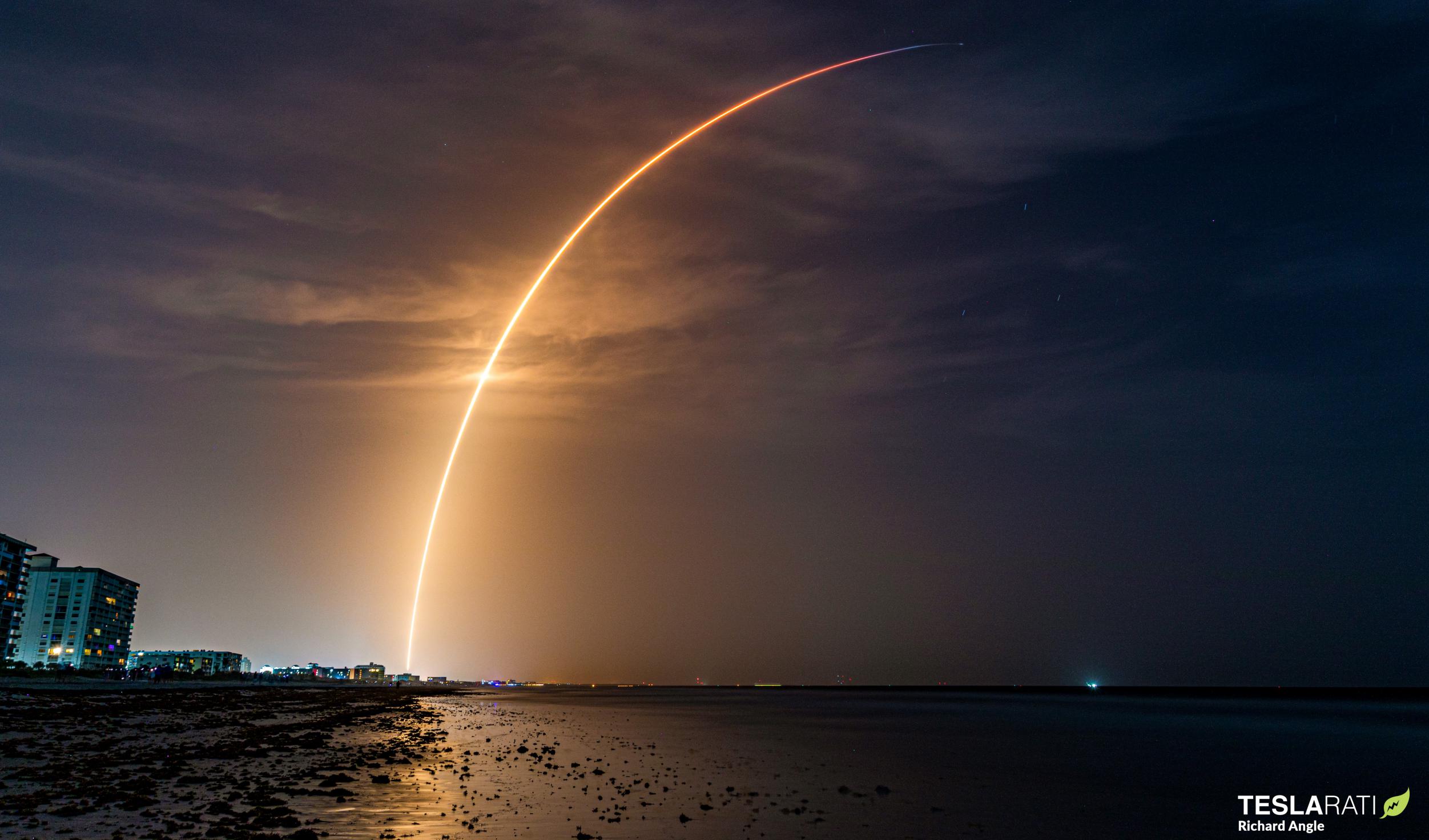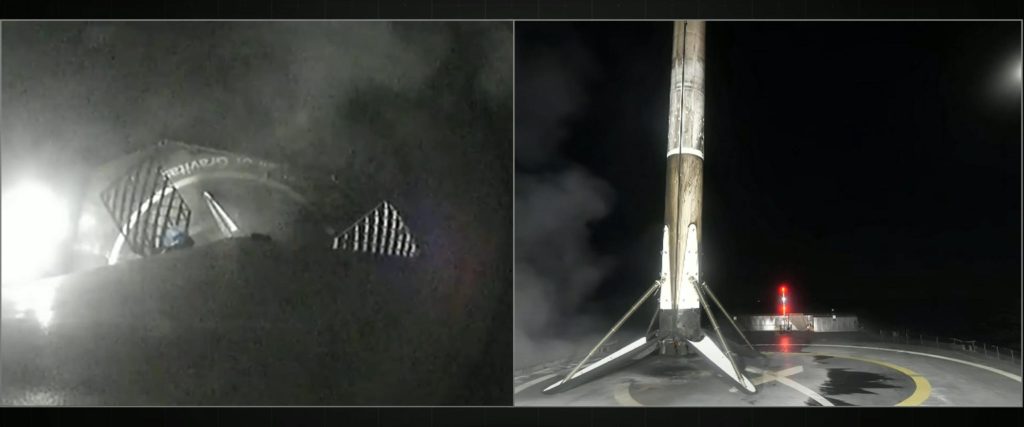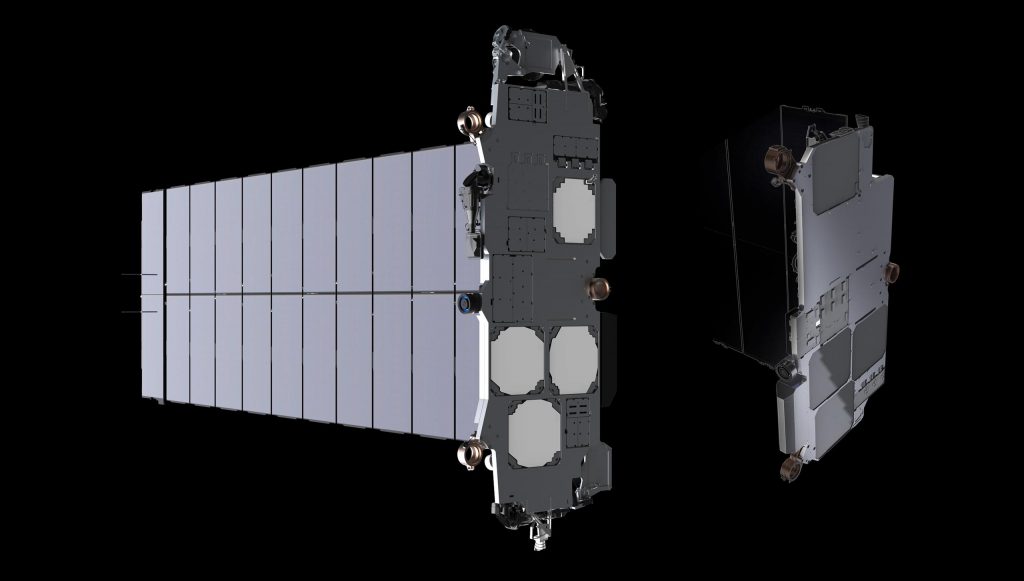

News
SpaceX launches 3000th Starlink satellite
SpaceX has successfully launched its 3000th Starlink satellite as part of Falcon 9’s 54th dedicated mission for the low Earth orbit (LEO) internet constellation.
After high upper-level winds forced SpaceX to call off a launch attempt three hours prior, Falcon 9 lifted off from NASA Kennedy Space Center (KSC) Launch Complex 39A at 10:14 pm EDT (02:14 UTC), carrying another 52 new Starlink V1.5 satellites inside the rocket’s flight-proven payload fairing. Like the fairing halves, both of which had already supported two orbital-class launches, the Falcon 9 booster (B1073) SpaceX assigned to the mission was also flying for the third time.
For the most part, Falcon 9 performed nominally. The booster lifted an expendable upper stage and the enclosed payload most of the way out of Earth’s atmosphere before separating and heading back to Earth. Falcon 9’s upper stage was as perfect as ever, boosting the Starlink stack the rest of the way into a low and elliptical parking orbit, where it eventually spun itself end over end and deployed all 52 satellites at once.
Falcon 9 booster B1073 made it through its reentry and landing burns without issue and safely touched down on drone ship A Shortfall Of Gravitas (ASOG) about nine minutes after liftoff. While that landing was ultimately a success, B1073’s accuracy was not exactly flawless and the booster came to a halt with two of its four legs unusually close to the edge of the drone ship’s deck. Had the booster missed the bullseye by just 5-10 more feet, it could have easily landed with one or two feet off the deck and tipped into the Atlantic.
Nonetheless, the landing was successful and SpaceX should have no issue recovering the booster. In any other context, it would barely be worth noting, but flawless Starlink launches with near-bullseye landings have become such a frequent and routine occurrence that any departure from that norm has become interesting.

Starlink 4-26 (referring to the 26th batch of Group or Shell 4 satellites) was SpaceX’s 54th dedicated Starlink launch overall and 21st Starlink launch in 2022 alone. The mission also carried SpaceX’s 3000th Starlink satellite into orbit, a milestone so far removed from the next largest satellite constellation that it’s now more reasonable to compare Starlink to every other satellite currently in orbit. Of the 3009 Starlink satellites SpaceX has now successfully launched since 2018, 2750 are still in orbit. Assuming all 52 Starlink 4-26 satellites are healthy, astrophysicist and space object tracker Jonathan McDowell estimates that SpaceX has 2714 working satellites in orbit.
Excluding 75 prototype satellites launched over the years, all but 5 of which have since deorbited, 92.3% of all operational Starlink satellites launched by SpaceX since November 2019 are still working in orbit. While Starlink V1.0’s 7.7% satellite failure rate is far from desirable, SpaceX has made clear progress with its V1.5 design, which began launching in September 2021. Excluding 38 satellites that were lost when a solar storm caused Earth’s atmosphere to expand, unexpectedly increasing drag to uncontrollable levels, only 10 of the 1218 Starlink V1.5 satellites SpaceX has launched have failed and prematurely reentered for technical reasons – a failure rate of 0.9%.

If SpaceX’s V1.5 satellites continue to demonstrate excellent reliability as they reach ages similar to their V1.0 predecessors, it will bode well for the sustainability and predictability of current and future Starlink constellations. Meanwhile, the roughly 2270 Starlink satellites that are currently operational continue to deliver internet services to hundreds of thousands of customers in countries around the world, improving the lives of countless people.
According to Next Spaceflight, SpaceX has up to five more Starlink launches scheduled this month as it continues to relentlessly pursue a record-breaking launch cadence with its Falcon 9 rocket. Up next, Starlink 3-3 could launch from California as early as August 12th. Photographer Ben Cooper reports that another East Coast Starlink mission is working towards a “mid-August” launch soon after.
Elon Musk
Tesla investors will be shocked by Jim Cramer’s latest assessment
Jim Cramer is now speaking positively about Tesla, especially in terms of its Robotaxi performance and its perception as a company.

Tesla investors will be shocked by analyst Jim Cramer’s latest assessment of the company.
When it comes to Tesla analysts, many of them are consistent. The bulls usually stay the bulls, and the bears usually stay the bears. The notable analysts on each side are Dan Ives and Adam Jonas for the bulls, and Gordon Johnson for the bears.
Jim Cramer is one analyst who does not necessarily fit this mold. Cramer, who hosts CNBC’s Mad Money, has switched his opinion on Tesla stock (NASDAQ: TSLA) many times.
He has been bullish, like he was when he said the stock was a “sleeping giant” two years ago, and he has been bearish, like he was when he said there was “nothing magnificent” about the company just a few months ago.
Now, he is back to being a bull.
Cramer’s comments were related to two key points: how NVIDIA CEO Jensen Huang describes Tesla after working closely with the Company through their transactions, and how it is not a car company, as well as the recent launch of the Robotaxi fleet.
Jensen Huang’s Tesla Narrative
Cramer says that the narrative on quarterly and annual deliveries is overblown, and those who continue to worry about Tesla’s performance on that metric are misled.
“It’s not a car company,” he said.
He went on to say that people like Huang speak highly of Tesla, and that should be enough to deter any true skepticism:
“I believe what Musk says cause Musk is working with Jensen and Jensen’s telling me what’s happening on the other side is pretty amazing.”
Tesla self-driving development gets huge compliment from NVIDIA CEO
Robotaxi Launch
Many media outlets are being extremely negative regarding the early rollout of Tesla’s Robotaxi platform in Austin, Texas.
There have been a handful of small issues, but nothing significant. Cramer says that humans make mistakes in vehicles too, yet, when Tesla’s test phase of the Robotaxi does it, it’s front page news and needs to be magnified.
He said:
“Look, I mean, drivers make mistakes all the time. Why should we hold Tesla to a standard where there can be no mistakes?”
It’s refreshing to hear Cramer speak logically about the Robotaxi fleet, as Tesla has taken every measure to ensure there are no mishaps. There are safety monitors in the passenger seat, and the area of travel is limited, confined to a small number of people.
Tesla is still improving and hopes to remove teleoperators and safety monitors slowly, as CEO Elon Musk said more freedom could be granted within one or two months.
News
Tesla launches ultra-fast V4 Superchargers in China for the first time
Tesla has V4 Superchargers rolling out in China for the first time.

Tesla already has nearly 12,000 Supercharger piles across mainland China. However, the company just initiated the rollout of the ultra-fast V4 Superchargers in China for the first time, bringing its quick-charging piles to the country for the first time since their launch last year.
The first batch of V4 Superchargers is now officially up and running in China, the company announced in a post on Chinese social media outlet Weibo today.
The company said in the post:
“The first batch of Tesla V4 Superchargers are online. Covering more service areas, high-speed charging is more convenient, and six-layer powerful protection such as rain and waterproof makes charging very safe. Simultaneously open to non-Tesla vehicles, and other brands of vehicles can also be charged. There are more than 70,000 Tesla Superchargers worldwide. The charging network layout covers 100% of the provincial capitals and municipalities in mainland China. More V4 Superchargers will be put into use across the country. Optimize the charging experience and improve energy replenishment efficiency. Tesla will accompany you to the mountains, rivers, lakes, and seas with pure electricity!”
The first V4 Superchargers Tesla installed in China are available in four cities across the country: Shanghai, Zhejiang, Gansu, and Chongqing.

Credit: Tesla China
Tesla has over 70,000 Superchargers worldwide. It is the most expansive and robust EV charging network in the world. It’s the main reason why so many companies have chosen to adopt Tesla’s charging connector in North America and Europe.
In China, some EVs can use Tesla Superchargers as well.
The V4 Supercharger is capable of charging vehicles at speeds of up to 325kW for vehicles in North America. This equates to over 1,000 miles per hour of charging.
Elon Musk
Elon Musk hints at when Tesla could reduce Safety Monitors from Robotaxi
Tesla could be reducing Safety Monitors from Robotaxi within ‘a month or two,’ CEO Elon Musk says.

Elon Musk hinted at when Tesla could begin reducing Safety Monitors from its Robotaxis. Safety Monitors are Tesla employees who sit in the front passenger seat during the driverless rides, and are there to ensure safety for occupants during the earliest rides.
Tesla launched its Robotaxi fleet in Austin last Sunday, and after eight days, videos and reviews from those who have ridden in the driverless vehicles have shown that the suite is safe, accurate, and well coordinated. However, there have been a few hiccups, but nothing that has put anyone’s safety in danger.
A vast majority — close to all of the rides — at least according to those who have ridden in the Robotaxi, have been performed without any real need for human intervention. We reported on what was the first intervention last week, as a Safety Monitor had to step in and stop the vehicle in a strange interaction with a UPS truck.
Watch the first true Tesla Robotaxi intervention by safety monitor
The Tesla and UPS delivery truck were going for the same street parking space, and the Tesla began to turn into it. The UPS driver parallel parked into the spot, which was much smaller than his truck. It seemed to be more of an instance of human error instead of the Robotaxi making the wrong move. This is something that the driverless cars will have to deal with because humans are aggressive and sometimes make moves they should not.
The Safety Monitors have not been too active in the vehicles. After all, we’ve only seen that single instance of an intervention. There was also an issue with the sun, when the Tesla braked abnormally due to the glare, but this was an instance where the car handled the scenario and proceeded normally.
With the Robotaxi fleet operating impressively, some are wondering when Tesla will begin scaling back both the Safety Monitors and Teleoperators that it is using to ensure safety with these early rides.
CEO Elon Musk answered the inquiry by stating, “As soon as we feel it is safe to do so. Probably within a month or two.”
As soon as we feel it is safe to do so.
Probably within a month or two. We continue to improve the Tesla AI with each mile driven.
— Elon Musk (@elonmusk) June 30, 2025
Musk’s response seems to confirm that there will be fewer Teleoperators and Safety Monitors in the coming months, but there will still be some within the fleet to ensure safety. Eventually, that number will get to zero.
Reaching a point where Tesla’s Robotaxi is driverless will be another significant milestone for the company and its path to fully autonomous ride-sharing.
Eventually, Tesla will roll out these capabilities to consumer-owned vehicles, offering them a path to generate revenue as their car operates autonomously and completes rides.
For now, Tesla is focusing on perfecting the area of Austin where it is currently offering driverless rides for just $4.20 to a small group of people.
-

 News5 days ago
News5 days agoTesla Robotaxi’s biggest challenge seems to be this one thing
-

 News2 weeks ago
News2 weeks agoTesla confirms massive hardware change for autonomy improvement
-

 Elon Musk2 weeks ago
Elon Musk2 weeks agoElon Musk slams Bloomberg’s shocking xAI cash burn claims
-

 News2 weeks ago
News2 weeks agoTesla features used to flunk 16-year-old’s driver license test
-

 News2 weeks ago
News2 weeks agoTesla China roars back with highest vehicle registrations this Q2 so far
-

 News2 weeks ago
News2 weeks agoTexas lawmakers urge Tesla to delay Austin robotaxi launch to September
-

 News2 weeks ago
News2 weeks agoTesla dominates Cars.com’s Made in America Index with clean sweep
-

 News2 weeks ago
News2 weeks agoTesla’s Grok integration will be more realistic with this cool feature





















